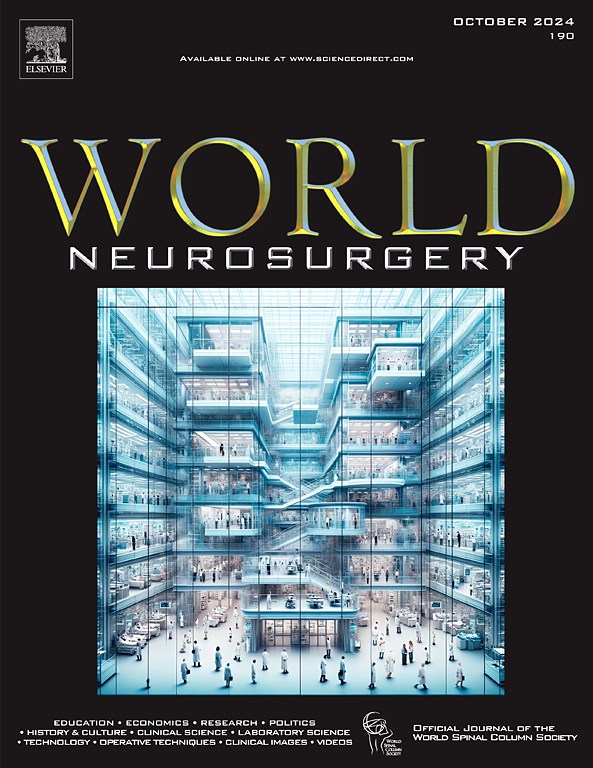Risk Factors for Incidental Durotomy in Initial Posterior Decompression Surgery for Lumbar Central Canal Stenosis with Bilateral Neurogenic Claudication
IF 2.1
4区 医学
Q3 CLINICAL NEUROLOGY
引用次数: 0
Abstract
Objective
To identify significant risk factors for incidental durotomy (ID) in initial posterior decompression surgery for lumbar central canal stenosis and to explore whether these risks vary by surgical approach through subgroup analyses.
Methods
This study included patients who underwent single-level posterior decompression surgery for lumbar central canal stenosis with bilateral neurogenic claudication at eight hospitals between April 2017 and May 2023. Patient demographics, comorbidities, and surgical details, including surgeon certification status, were collected. Statistical analyses included the chi-square test or Fisher exact test for categorical variables and Student t test for continuous variables. Multivariate binary logistic regression analysis was performed for the entire cohort and subgroups stratified by surgical approach.
Results
ID occurred in 6.3% (95/1512) of cases. For the entire cohort, both univariate and multivariate analyses identified female sex, oral anticoagulant/antiplatelet use, and oral steroid use as significant risk factors. However, the independent risk factors for ID differed by surgical approach. In conventional open laminectomy, multivariate analysis identified oral anticoagulant/antiplatelet use (odds ratio [OR] 3.0, 95% confidence interval [CI]: 1.15–7.67) and oral steroid use (OR 5.8, 95% CI: 1.38–24.8) as significant risk factors. In contrast, in microendoscopic surgery, female sex (OR 2.0, 95% CI: 1.19–3.47) was a significant risk factor, while surgery performed by a certified instructor was protective (OR 0.46, 95% CI: 0.29–0.82).
Conclusions
Risk factors for ID are dependent on surgical approach. For open procedures, pharmacological factors are paramount, while for microendoscopic procedures, female sex and surgeon experience are critical. Preventive strategies should be tailored to the surgical method.
腰椎中央管狭窄伴双侧神经源性跛行初始后路减压手术中意外硬膜切开的危险因素。
目的:通过亚组分析,确定腰椎中央管狭窄初始后路减压手术中偶发硬膜切开(ID)的重要危险因素,并探讨这些风险是否因手术入路而异。方法:本研究纳入2017年4月至2023年5月在8家医院接受单节段后路减压手术治疗腰椎中央管狭窄伴双侧神经源性跛行的患者。收集了患者统计资料、合并症和手术细节,包括外科医生的认证状态。统计分析包括对分类变量的卡方检验或Fisher精确检验,对连续变量的学生t检验。对整个队列和按手术入路分层的亚组进行多元二元logistic回归分析。结果:ID发生率为6.3%(95/ 1512)。对于整个队列,单因素和多因素分析均确定女性、口服抗凝/抗血小板药物使用和口服类固醇使用是重要的危险因素。然而,不同手术入路的独立危险因素不同。在传统的开放式椎板切除术中,多因素分析发现口服抗凝血/抗血小板使用(OR 3.0, 95% CI: 1.15-7.67)和口服类固醇使用(OR 5.8, 95% CI: 1.38-24.8)是显著的危险因素。相比之下,在显微内窥镜手术中,女性(OR 2.0, 95% CI: 1.19-3.47)是显著的危险因素,而由认证讲师进行的手术是保护性的(OR 0.46, 95% CI: 0.29-0.82)。结论:ID的危险因素取决于手术入路。对于开放式手术,药理学因素是最重要的,而对于显微内镜手术,女性和外科医生的经验是至关重要的。预防策略应与手术方法相适应。
本文章由计算机程序翻译,如有差异,请以英文原文为准。
求助全文
约1分钟内获得全文
求助全文
来源期刊

World neurosurgery
CLINICAL NEUROLOGY-SURGERY
CiteScore
3.90
自引率
15.00%
发文量
1765
审稿时长
47 days
期刊介绍:
World Neurosurgery has an open access mirror journal World Neurosurgery: X, sharing the same aims and scope, editorial team, submission system and rigorous peer review.
The journal''s mission is to:
-To provide a first-class international forum and a 2-way conduit for dialogue that is relevant to neurosurgeons and providers who care for neurosurgery patients. The categories of the exchanged information include clinical and basic science, as well as global information that provide social, political, educational, economic, cultural or societal insights and knowledge that are of significance and relevance to worldwide neurosurgery patient care.
-To act as a primary intellectual catalyst for the stimulation of creativity, the creation of new knowledge, and the enhancement of quality neurosurgical care worldwide.
-To provide a forum for communication that enriches the lives of all neurosurgeons and their colleagues; and, in so doing, enriches the lives of their patients.
Topics to be addressed in World Neurosurgery include: EDUCATION, ECONOMICS, RESEARCH, POLITICS, HISTORY, CULTURE, CLINICAL SCIENCE, LABORATORY SCIENCE, TECHNOLOGY, OPERATIVE TECHNIQUES, CLINICAL IMAGES, VIDEOS
 求助内容:
求助内容: 应助结果提醒方式:
应助结果提醒方式:


